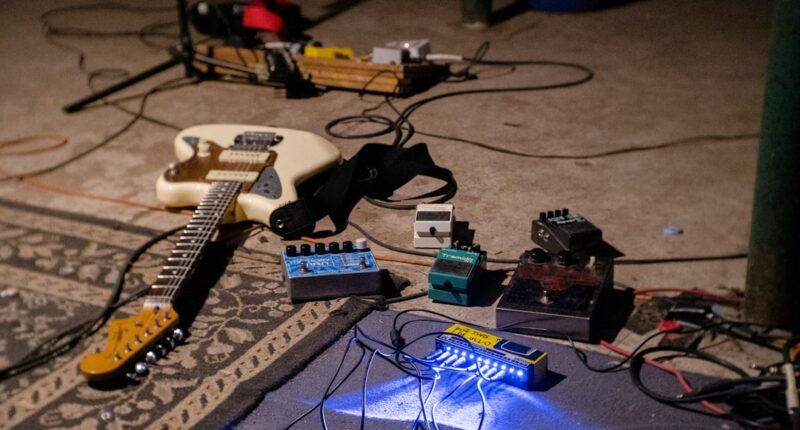To embark on a journey of mastering the guitar, one must first grasp the fundamental layout of the fretboard. The fretboard is divided into frets, which are the metal strips that run horizontally across the neck of the guitar. Each fret represents a half-step in pitch, and as you move up the neck, the notes ascend in pitch.
The strings themselves are numbered from the bottom to the top, with the lowest string (the thickest) being the sixth string and the highest string (the thinnest) being the first. Understanding this layout is crucial for any guitarist, as it serves as the foundation for playing scales, chords, and melodies. Familiarizing oneself with the names of the notes on each string and fret will enable a player to navigate the instrument with confidence and precision.
Moreover, recognizing the relationship between the notes on the fretboard is essential for developing a deeper understanding of music theory. For instance, each note on a string can be found at various frets on adjacent strings, creating a web of interconnected notes. This interconnectedness allows for greater flexibility in playing and improvisation.
By learning to visualize these patterns, guitarists can easily transpose songs into different keys or create their own unique compositions. Additionally, understanding how to read tablature and standard notation can further enhance a player’s ability to communicate musical ideas effectively. Thus, mastering the basics of the fretboard is not merely about memorizing notes; it is about cultivating a comprehensive understanding that will serve as a springboard for more advanced techniques.
Key Takeaways
- Understanding the basics of the fretboard is essential for any guitarist to navigate and play effectively.
- Navigating scales and chords is crucial for creating melodies and harmonies on the fretboard.
- Developing finger dexterity and coordination is key to mastering complex guitar techniques and playing styles.
- Utilizing open and barre chords expands the range of sounds and possibilities for guitar playing.
- Expanding your repertoire with different tunings can add depth and variety to your guitar playing.
Navigating Scales and Chords
Once a guitarist has a solid grasp of the fretboard, the next step is to delve into scales and chords. Scales are sequences of notes that follow a specific pattern, and they form the building blocks of melodies and solos. The most common scale is the major scale, which consists of seven notes and follows a whole and half-step pattern.
By practicing scales in various positions on the fretboard, players can develop their ear for music and improve their improvisational skills. Additionally, scales can be transposed into different keys, allowing guitarists to play along with other musicians or adapt songs to their vocal range. Chords, on the other hand, are combinations of three or more notes played simultaneously.
They provide harmonic support for melodies and are essential for rhythm playing. Understanding how to construct major, minor, diminished, and augmented chords is vital for any guitarist. Furthermore, learning chord progressions—sequences of chords played in succession—can help players create their own songs or accompany others.
By combining scales and chords, guitarists can explore a vast array of musical styles and genres. This knowledge not only enhances their technical skills but also deepens their appreciation for music as an art form.
Developing Finger Dexterity and Coordination

As guitarists progress in their playing journey, developing finger dexterity and coordination becomes increasingly important. Finger dexterity refers to the ability to move fingers independently and accurately across the fretboard. This skill is crucial for executing complex riffs, solos, and chord changes smoothly.
One effective way to improve dexterity is through finger exercises that focus on stretching and strengthening each finger individually. Simple exercises such as chromatic scales or fingerpicking patterns can significantly enhance a player’s control over their fingers, allowing them to navigate the fretboard with greater ease. Coordination between both hands is equally essential for proficient guitar playing.
The left hand (or fretting hand) must work in harmony with the right hand (or picking hand) to produce clean notes and rhythms. Practicing scales and chords slowly at first can help build this coordination, allowing players to focus on timing and accuracy before increasing speed. Additionally, incorporating techniques such as alternate picking or fingerstyle can further develop coordination skills.
As players become more comfortable with their finger movements, they will find themselves able to tackle more challenging pieces of music with confidence.
Utilizing Open and Barre Chords
| Chord Type | Advantages | Disadvantages |
|---|---|---|
| Open Chords | Easy for beginners, produce a full sound | Limited voicings, can be challenging to switch between chords |
| Barre Chords | Allow for more chord voicings, easier to switch between chords | Can be challenging for beginners, require finger strength |
Open chords and barre chords are two fundamental types of chords that every guitarist should master. Open chords are formed using one or more open strings, which means that some strings are played without being fretted. These chords are typically easier to play and are commonly used in folk, rock, and pop music.
Learning open chords such as C, G, D, A, and E allows beginners to accompany themselves while singing or playing along with others. The rich sound produced by open strings adds depth to these chords, making them a staple in many musical genres. On the other hand, barre chords present a more advanced challenge but offer greater versatility across the fretboard.
A barre chord involves using one finger to press down multiple strings across a single fret, effectively creating a movable chord shape. This technique allows guitarists to play chords in any key by simply shifting their hand position up or down the neck. While barre chords may initially feel uncomfortable or require more strength in the fingers, consistent practice will lead to improved muscle memory and ease of play.
Mastering both open and barre chords equips guitarists with a diverse toolkit for songwriting and performance.
Expanding Your Repertoire with Different Tunings
Exploring different tunings can significantly expand a guitarist’s repertoire and creativity. Standard tuning (EADGBE) is the most common tuning used by guitarists; however, alternative tunings can unlock new sonic possibilities and inspire fresh musical ideas. For instance, drop D tuning (DADGBE) lowers the sixth string by a whole step, allowing for powerful power chords and unique voicings that are prevalent in rock music.
Similarly, open tunings such as open G (DGDGBD) or open D (DADF#AD) create rich harmonic textures that lend themselves well to slide guitar playing or folk styles. Experimenting with different tunings not only broadens a guitarist’s technical skills but also encourages improvisation and composition. When strings are tuned differently, familiar chord shapes yield new sounds and progressions that can lead to unexpected musical directions.
This exploration can be particularly beneficial for songwriters seeking to break free from conventional patterns or for performers looking to add variety to their live sets. By embracing alternative tunings, guitarists can cultivate their unique sound while enhancing their overall musicianship.
Mastering Fretboard Visualization and Memorization

Fretboard visualization is an essential skill that allows guitarists to navigate their instrument with confidence and fluidity. It involves mentally mapping out the notes on the fretboard so that players can quickly identify where specific notes or patterns are located without having to think about it consciously. One effective way to develop this skill is through regular practice of scales and arpeggios in various positions across the neck.
By consistently playing these patterns while visualizing their shapes on the fretboard, guitarists can reinforce their memory of note locations. Additionally, memorization techniques such as associating notes with visual landmarks or using mnemonic devices can aid in this process. For example, recognizing that certain frets correspond to specific notes (e.g., the third fret on the sixth string is G) can help solidify one’s understanding of the fretboard layout.
As players become more adept at visualizing the fretboard, they will find it easier to improvise solos or create chord progressions on-the-fly during jam sessions or performances. Ultimately, mastering fretboard visualization enhances overall musicianship by fostering a deeper connection between a guitarist’s mind and their instrument.
Implementing Techniques for Fluid Soloing
Fluid soloing is an art form that requires both technical proficiency and creative expression. To achieve this level of mastery, guitarists must develop a repertoire of techniques that enhance their ability to improvise melodically over chord progressions. Techniques such as bending strings, hammer-ons, pull-offs, slides, and vibrato add nuance and emotion to solos while allowing players to articulate their musical ideas more effectively.
Practicing these techniques in conjunction with scales will help players integrate them seamlessly into their playing style. Moreover, listening to accomplished guitarists across various genres can provide valuable insights into soloing techniques and phrasing. Analyzing how different artists approach improvisation can inspire new ideas and encourage players to experiment with their own style.
Additionally, recording oneself while soloing can be an effective way to identify areas for improvement and track progress over time. By combining technical skills with creative exploration, guitarists can develop fluid soloing abilities that captivate audiences and express their unique musical voice.
Integrating Fretboard Mastery into Your Playing Style
Ultimately, integrating fretboard mastery into one’s playing style is about finding personal expression within the framework of technical skills acquired over time. As guitarists become proficient in navigating scales, chords, finger dexterity, and soloing techniques, they should strive to incorporate these elements into their unique sound. This process often involves experimenting with different genres, techniques, and compositional approaches until players discover what resonates most with them artistically.
Furthermore, collaboration with other musicians can greatly enhance this integration process. Playing with others exposes guitarists to diverse styles and perspectives that can inspire new ideas and approaches to their own playing. Whether jamming with friends or performing in a band setting, these experiences foster growth as musicians while encouraging creativity in integrating fretboard mastery into one’s personal style.
Ultimately, embracing this journey allows guitarists not only to become skilled players but also to express themselves authentically through their music.









